| Please access the following URL if you want to secure using SSL. All pages in the site will be secure pages. |
| https://secure02.blue.shared-server.net/www.fish-food.co.jp/message english 5.2020.html |
Welcome to FISH FOOD TIMES
May. 2020 issue No.197

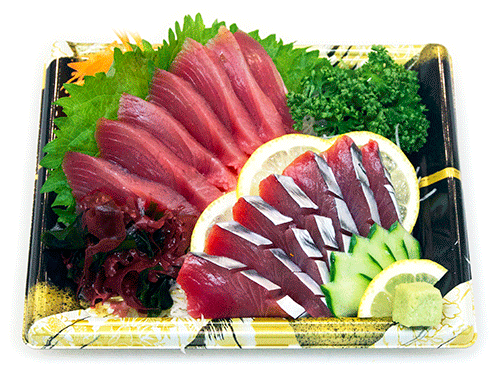
Bonito silver skin sashimi
Blue leaves became more prominent in the field, and a singing cry of little cuckoo was heard in the mountains, and the first bonito came in the nearby sea.
In the world, the movement of people is restricted due to the influence of the new coronavirus, economic activity has stagnated and time has stopped, but nature is this regardless of such a disturbance in the human world. As ever, the leaves of the trees are becoming bluer, birds sing in the mountains, and bonitos come with the Kuroshio from the warm waters of the south.
May is the season when bonito comes closest to the coast of the Japanese archipelago in the year, so it is possible to take a day trip of the bonito fishing boat caught in the near sea, so leave bonito in a fresh state, It is time to eat sashimi and sushi.
According to the bonito spring fishing forecast for the waters around Japan announced on February 3, 2020 by the National Research Institute for Fisheries Research and Development, International Resource Research Institute, and Central Fisheries Research Institute, the Kuroshio from the shore to the extreme from 2018 to this year. The large meandering away from the sea continues, and this seems to be affecting the bonito catch.
The Kuroshio meander has N, A, B, C, D patterns, as shown in the figure below,
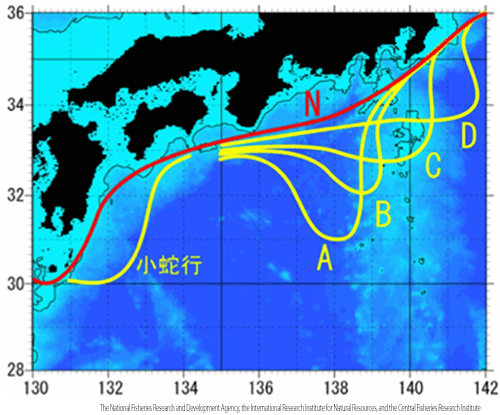
For this year, they expect to look something like the figure below.

Judging from this figure, it seems that this year's bonito spring fishing may be between the extremely bad landing type A and the not so bad type B fishery.
The future of skipjack catch and price is uncertain. However, given the stagnant economic situation in the world today, it is unlikely that the price of bonito will soar, and it can be inferred that the price will remain stable.
Commercialization of bonito
It is normal to treat fresh bonito caught in the waters near Japan during this season, and it is not unusual for fisheries workers to treat it. The process image of how to dismantle this and commercialize it may not be necessary anymore, but I think that there may be one thing that may be helpful, so I decided to follow my method below. Let me introduce you.
| Dismantling process until bonito harakawa is separated | |
 |
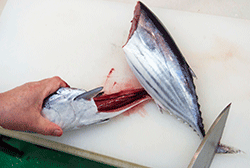 |
| 1,Fishing bonito with good freshness | 6,Grasp the head with your left hand and pull the head and internal organs together to remove it from the fish body. |
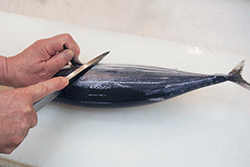 |
 |
| 2,Make a cut at the lower body pectoral fin, cut the backbone, and stop leaving the abdomen about one-third. | 7,The head part with internal organs attached and the fish body part separated. |
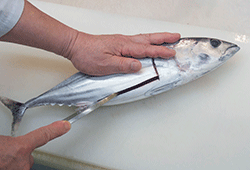 |
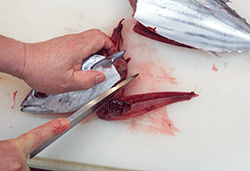 |
| 3,Cut the abdomen vertically from the notch to the anus. | 8,Cut the root of the harakawa part so as to avoid the internal organs attached to the head, and remove it. |
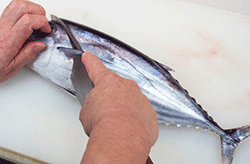 |
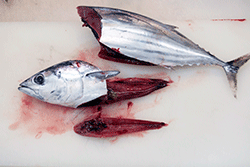 |
| 4,The upper body is notch from around the backbone, and the knife is stopped while leaving the abdomen about one third. | 9,The state where the harakawa part is separated. |
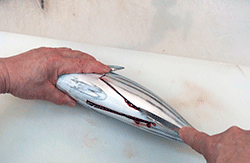 |
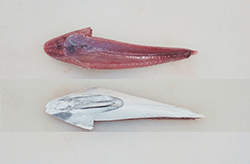 |
| 5,With the pelvic fin part of the abdomen left uncut, cut open to the anus. | 10,Harakawa is a separate product for rare parts. |
The part of bonito harakawa is the same as bluefin tuna's ootoro, and the larger the fish body of bonito, the more fat and delicious it becomes. However, in the case of small bonito, there is a fact that it is almost thrown away in the fresh fish department because the belly is thin and there are few edible parts.
However, in the part of bonito, it is the part of toro with the highest amount of fat, so harakawa should not be bad. Kagoshima, which is a major landing site for bonito, has a history that it has been eaten as a cheap popular item for a long time as a surplus product produced when making bonito flakes at the factory, and it is one of the specialty products in the Kagoshima region. For example, a restaurant in Makurazaki sells in the following form.
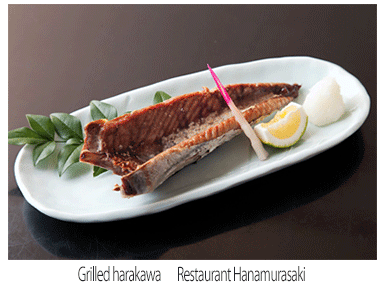
Of course, harakawa can be eaten with sashimi if it is fresh, but after all it has a structure like a "snake's belly", so if it is processed with a kitchen knife it loses its shape and looks bad. , I find it difficult to make sashimi products. The bonito sashimi is delicious enough in parts other than harakawa, so I think it's best not to force it into sashimi, but to grill it with salt as shown in the image.
In the case of the author, the work of three pieces disassembling to make the bonito body part into sashimi is performed as follows.
| Bonito's three pieces disassembling work process | |
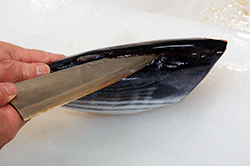 |
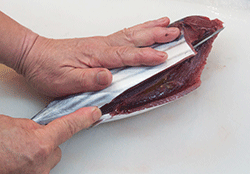 |
| 1,Using a reverse knife, insert the knife under the wakaremi at the dorsal fin of the lower body, and then cut toward the head. | 7,Switch the knife from the deba knife to the yanagiba knife and cut open from the side of the anal fin on the lower body to the backbone. |
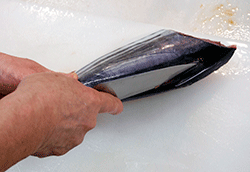 |
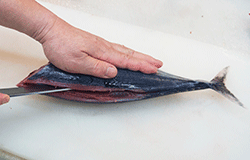 |
| 2,The upper body side is also a reverse hand knife, insert the cutting edge of the knife under wakaremi on the side of the dorsal fin, and cut it toward the head side. | 8,Insert the edge of yanagiba between the removed dorsal fins, cut open to the backbone, and cut off to the head side. |
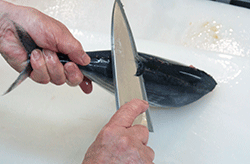 |
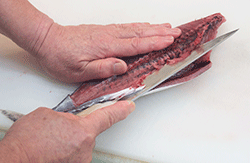 |
| 3,Make a notch by hitting the blade edge of the knife with the edge of the dorsal fin on the tail side and tapping with the blade edge. | 9,To remove the upper body side, first place the central bone on top, and then cut open from the side of the upper body fin to the backbone. |
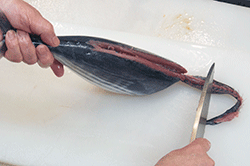 |
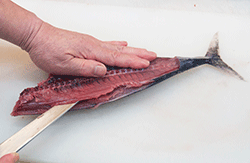 |
| 4,While continuing to cut the blade of the knife, proceed to the head side and separate the dorsal fin from the body. | 10,With the central bone on top, insert the cutting edge under the central bone from the dorsal fin and cut open to the backbone. |
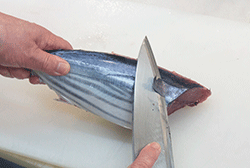 |
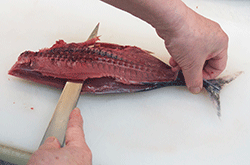 |
| 5,Remove the scales on the lower body by moving them with a kitchen knife as if shaving. | 11,Insert yanagiba under the backbone of the tail, cut it toward the head side, and separate the central bone. |
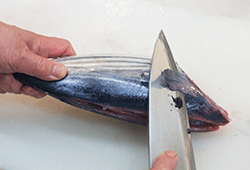 |
 |
| 6,Also on the upper body side, move the kitchen knife as if shaving, and remove it so as not to leave scales. | 12,The bonito is made into three pieces disassembling. |
As shown in the image above, in the case of bonito, the auther replaces the deba knife with the yanagiba knife and performs three pieces disassembling work. The whole process may be done with a deba knife, but I also use the yanagiba knife for the purpose of avoiding cracking of small bonito and tuna fish such as albacore tuna and striped bonito as well as soft bonito. I think there are the opinion of pros and cons to this method, but I'll note that I do it anyway because it's easy to do.
Next, let's introduce the work process of silver skin sashimi in the first page image.
| Bonito silver skin sashimi work process | |
 |
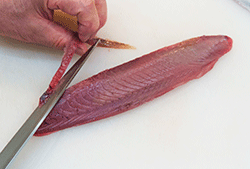 |
| 1,Remove the belly bone. | 7,For the back body from which the skin has been removed, the remaining blood vessels are removed as if shaving with the cutting edge. |
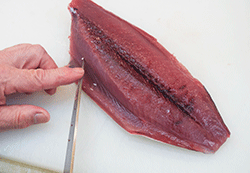 |
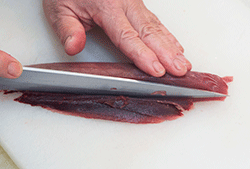 |
| 2,The bonito insects (Tentaclaria) are harmless to eat, but they are all removed using the knife tip. | 8,Remove the chiai meat of fish left in the back body and belly body by cutting it into a V shape. |
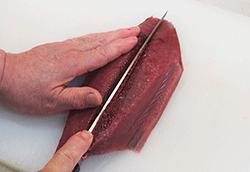 |
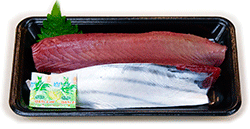 |
| 3,In order to remove the skin of the back body, notch the cutting edge on the back body side of the chiai meat of fish part. | 9,Product of "bonito silver skin sashimi tanzaku set" with belly body with skin left and back body with skin removed |
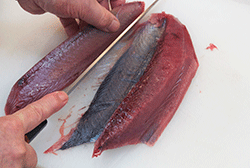 |
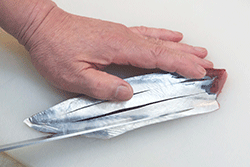 |
| 4,When the blade reaches the skin, change it to an L-shaped angle and move it to the left, and then separate the back body and the skin. | 10,To make silver skin sashimi, put a few decorative cuts on the skin of belly body. |
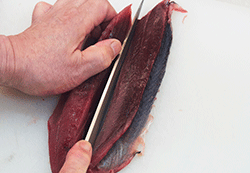 |
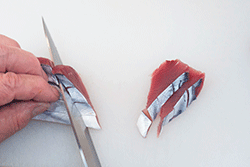 |
| 5,In the case of belly body, insert the cutting edge on the belly body side of the chiai meat of fish, cut it down as it is, and separate the belly body. | 11,The belly body is made of hiratsukuri sashimi with a slightly thicker feel, as the silvery skin stands out. |
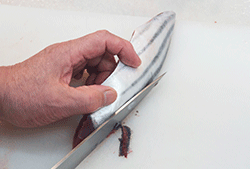 |
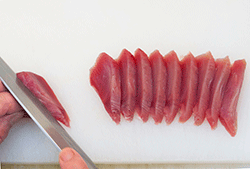 |
| 6,Carefully remove all the small scales left on the skin of the belly body as if shaving. | 12,For bonito, which has a soft constitution, cut the back body thicker to leave a texture. |
 |
|
| Completion of bonito silver skin sashimi | |
Actually, this is the second time to introduce bonito silver skin sashimi at FISH FOOD TIMIS. Approximately 13 years ago, the September 2006 issue No.33 "Tataki & silver skin sashimi" dealt with similar products. It was the third year since the FISH FOOD TIMES started, and I still didn't have the time to put in the effort and the content was poor, so I think I'll have to pick up on bonito again. It was That thought was realized this time, but there are several other fish such as Japanese seabass and Japanese flying squid that I think that I need to rewrite a solid and respectable article as well. I think that the time will come someday.
Silver skin sashimi is a method of eating sashimi with the skin without removing the skin of the belly body of bonito, but the basic idea is the same as hot water frost, and you can enjoy the texture and taste of the skin. It is one. It is called silver skin because the color of the abdomen of bonito is silver. Basically, it is eaten raw as it is, but if warm water frost is used with warm water, it becomes a little softer and easier to eat. Since the skin of the back body is too hard, it is difficult to eat unless heat is applied such as fire, and it is a method that can be applied only to the belly body.
There is such a method when sushi is used for the silver skin sashimi.
| Bonito silver skin sushi is plenty of products |
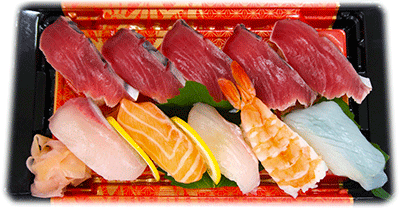 |
| ¥ 680 |
According to the market price, raw skipjack is at least 300 yen / kg to 700 yen / kg depending on the size and the freshness. When it exceeds 1,000 yen / kg, it can be considered that there is no other fish, and it is reasonable to think that it is 500 yen / kg on average.
If bonito is available at a price of about 500 yen / kg, the yield rate will be 33%. If you cut 12 g of sushi, 90 yen for 5 kan, 180 yen for all other sushi materials, 10 kan for shari. Is 100 yen in total. Furthermore, if the container costs 30 yen, the total is 400 yen. If the selling price is 680 yen, the markup ratio will be about 40%. If fresh bonito sushi with a freshness is combined with other nigiri sushi for a selling price of 680 yen for 10 cans, this might be a sufficiently attractive product.
Fish called bonito is a very attractive ingredient in terms of price, and needless to say, bonito flakes are also the basis of Japanese food culture. Not only that, but I would like to mention a little below that it is an excellent nutritional ingredient.
Add resistance with bonito nutrition
The ragingness of the new coronavirus is raging all over the world. In order not to be infected with this virus, it seems that the most important thing for human beings is to "provide a strong resistance against the virus" rather than a coping therapy such as masks and disinfection.
And I'm very worried about after the corona turmoil has ended. It means that "masks and disinfection become the world of common sense." I think that in such a world, the number of people with weak constitutions that are not resistant to diseases will increase.
Even though I'm 70 years old, I still have a cold once a year, and I have no illness at all, and I always have a strong body that I do not know. "In the body composition meter of the house, the body age 45 is always displayed."
The key to this health is Koichiro Fujita, a professor emeritus at Tokyo Medical and Dental University, who wrote that "the human life is 90% of the intestines (Wanibooks)" and "the habit of damaging and training the intestines (Wanibooks)". I think it is because I am referring to the idea written in. I have been practicing this for the last 10 years at the level I can.
In these books, Professor Fujita states:
The intestine has three major functions: digestion, immunity, and detoxification. The intestine is the largest immune system in the human body, food is absorbed from the small intestine, and even if pathogenic bacteria enter the body, it can be prevented if it is not absorbed from the small intestine. The small intestine is the immune system called the largest fortress in the human body. Supporting the immune system is an intestinal bacterium called a symbiotic bacterium that lives in the 20,000 kinds of 1,000 trillion intestines. The intestine is responsible for 70% of the immune function, but if immune functions are distinguished, they can be divided into infection defense, health maintenance, and aging prevention. Whether you get a cold or flu depends on the strength of your immunity, so if your intestines are healthy, you can prevent infection with the virus, and if your function is weak, you will catch a cold. The bactericidal act that the Japanese are working on every day is an act that damages the intestinal bacteria that coexist in the intestines and weakens the immunity. The number of adults with measles, norovirus, or rotavirus, once said to be a disease of children with weak immune system, is due to abuse of fungicides and antibacterial agents. Immunity is strengthened and strengthened each time it fights a nearby pathogen. Simply eliminating the bacteria only weakens the immune system by losing the opportunity to train it. Escherichia coli is a symbiotic bacterium that lives in the intestine and is indispensable for human life. It is like a sentinel that works to get rid of pathogenic bacteria when they enter the body, and it also works to synthesize vitamins while breaking down indigestible dietary fiber to feed itself. Humans take a wide variety of bacteria into their intestines during the first year of life, and the richness of the intestinal flora determines the core of their health status throughout their lives. A baby can develop immunity by crawling and licking the hands of the fungus on the floor. A variety of indigenous bacteria that feed on the skin's fat are inhabited on the skin, and when the indigenous bacteria eat fat, a fatty acid film is created, which creates a weakly acidic barrier on the skin and prevents pathogenic bacteria from attaching. However, if you wash your hands with soap, about 90% of the bacteria that are indigenous to the skin will disappear, and a medicated mouthwash will drastically reduce the bacteria that protect your throat health. Viruses and bacteria that cause infectious diseases are more likely to adhere to the hands and throat that are free of indigenous bacteria and oral bacteria. The stratum corneum of the skin is the uppermost layer of the skin and is the hardest part of the skin that functions to prevent invasion of external enemies. The cells of the stratum corneum are dissociated when the sebaceous membrane is lost, and pathogens and allergens are easily invaded. When a foreign substance enters through a gap in the skin, the immune system reacts, causing inflammation such as itch and eczema. If you use drugs regularly to keep away bacteria, your immune system will be sluggish and your immune system will be weakened. |
Professor Fujita is advocated that "in order for people to stay healthy and live longer, it is important to improve their immunity. To that end, it is important to keep the intestinal environment healthy."
The auther is something I always do every day as a dietary habit to keep the intestinal environment healthy. That is the "pre-meal cabbage" recommended by Professor Fujita. This is a healthy way to eat a small plate of cabbage before eating. Dietary fiber is a favorite of intestinal bacteria, and if you eat a diet rich in dietary fiber, the intestinal balance will be in the best state, while the intestinal bacteria will increase in number and movement will be activated and human life will increase. It is said that it will move in the direction of protecting. It's such an easy thing, and at home, my wife will always serve "heap of cabbage with ponzu sauce" before dinner for many years. Also, my favorite tavern owner silently puts out "heap of cabbage" first. There aren't many other cheap and easy ways to stay healthy.
In addition to cabbage, this book describes various ways to improve the intestinal environment, so I recommend that you read this book as well. And eating bonito isn't a good thing in this book, but I'll briefly explain it below.
The human body is made up of 20% protein, and in order to enhance human immunity, proteins that promote metabolism are necessary. Bonito is rich in animal protein that contains essential amino acids in a well-balanced manner, and as much as protein occupies a quarter of the fish body, the content per 100 g of edible portion is 25.8 g, which is Over 24.3g tuna. Bonito is not only rich in protein, but in addition to the well-known DHA and EPA, it is also rich in vitamin D, B6, B12, and niacin. Recently, it has also been noted that it contains a large amount of selenium, which activates the longevity hormone DHAE from the adrenal gland.
In short, in order for people to be resistant, it is necessary to eat nutritious fish like bonito as the staple food and eat miso soup and natto recommended by Professor Fujita and vegetables rich in dietary fiber as side dishes together in good balance. I want to say that it is important.
I was also affected by the new coronavirus, and the company's sales had fallen to a level that was more than half. However, I will optimistically think that the rain of the corona will stop soon, and that the darkness of the night, which is surrounded by pitch-black corona evil, will not disappear.
The retailers who operate the fish counter in the store may be busy thinking about "nesting consumption". It is speculated that sales may be increasing without making a special promotion, but it seems that the fear of virus infection is very sensitive.
Readers, please take good care of yourself and continue your work.
| Please access the following URL if you want to secure using SSL. All pages in the site will be secure pages. |
| https://secure02.blue.shared-server.net/www.fish-food.co.jp/message english 5.2020.html |
An opinion and the communication are to iinfo@fish food times
Date of updating 1 May. 2020
